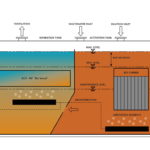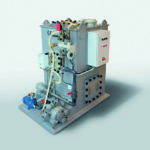Stringent regulations and tight retrofit budgets need new solutions have led to ACO Marine developing a new wastewater treatment system instead of adapting conventional technology
The 100th unit of the new Clarimar MF was delivered just two-years after product launch. A Clarimar MF-3[ds_preview] unit was supplied in April for retrofit installation to the 1973-built 58.3m tugboat »Lautaro« (ATF-67), operated by the Armada de Chile. »That a new wastewater treatment system can penetrate what is an already established market in just two-years is testament to the ability of ACO Marine’s engineering team to design systems capable of meeting market demand for smaller, safer and cost-effective wastewater treatment solutions,« says ACO Marine’s managing director Mark Beavis.
Over the past few years, ACO Marine has invested 20% of its turnover annually into product research and development which has resulted in new wastewater treatment and grease separation systems, all of which have been designed to cost-effectively meet stringent IMO and USCG regulations while optimising operational performance.
»There was no point continuing with the previous version of the Clarimar as it was similar to other systems on the market that adopt conventional technology. We developed a completely new technology. So, for us to come in with the Clarimar MF and take orders from more established brands in a relatively short time is a remarkable achievement.«
The biological-type ACO Clarimar MF system and its pollution-preventing »bio-sword« innovation was officially introduced during Hamburg’s SMM exhibition, in September 2014. »We needed to develop a wastewater treatment concept that was not only smaller, safer and more cost-effective than our competitors, but also a system that provided a physical barrier against pollution and illegal, or accidental, discharges. That is exactly what we have achieved with the Clarimar MF,« recalls Beavis. The wastewater solution aims at balancing foot-print, corrosion-resistance, safety, reliability and price – backed up with a life-time guarantee against corrosion of the tank.
The »Lautaro« installation followed a V.Ships Offshore contract to retrofit a wastewater management system aboard the 8234t Dive Support Vessel (DSV) »Bibby Polaris«. The company, a division of Germany’s ACO Group, was tasked with changing the vessel’s wastewater management system to one capable of meeting new MEPC 227(64) requirements.
However, the project was a challenge in that available machinery space was severely limited and the project had an assembly time of just two weeks. »A regular retrofit project like this would probably take twice that time, with a considerable amount of work undertaken by the shipyard to create access routes through the ship’s side and move existing equipment to clear a path to the installation site. A conventional installation would have meant cutting quite a large hole into the hull and redirecting a substantial amount of pipe work to get the 3.82m x 2.35m x 2.07m Clarimar MF-10 unit into position, resulting in significantly increased costs and time. But we took a more radical approach to retrofit installation,« Beavis says.
That radical approach was to design the Clarimar MF for supply and installation as a flat-pack, allowing it to be fed in sheet-by-sheet to the machinery space for final welding in-situ. »As far as I’m aware, it is one of only a few large pieces of engine room machinery to have been supplied to a ship as an ›onboard build‹ and we believe this could be the way forward for all sorts of machinery space equipment, especially where space is limited or timeframes are tight.
Delivering machinery flat-packed, ready for construction and welding in-situ saves a considerable amount of time during the planning and installation stages. We are also able to keep costs down to a minimum as there is no need to cut large holes into the vessel’s structure and patch them up again. Beavis believes it will even be possible to supply, install and commission systems while the vessel is still operational, although this will be dependent on a number of factors and will have to be considered on a project-by-project basis.
Grease, often overlooked
However a ship’s wastewater treatment unit is supplied, whether it’s for a retrofit or newbuild installation, there is an important part of the treatment process that is often overlooked: grease.
Grease is a huge problem and usually dealt with by way of a grease trap. Yet, while these systems are reasonably effective if regularly cleaned, the reality is that congealed fat quickly accumulates, clogging up and damaging pipework and, ultimately, the wastewater treatment plant.
Black water (sewage) discharge is heavily regulated, of course, but waste streams from galleys, showers and laundries (grey water), are not. There are no internationally mandated rules, only local/national discharge requirements for a stream that contains a mixture of galley grease, oils and fats, biological pollutants, such as urine and blood, nano-plastics from shampoos and soaps, along with an increasingly wider range of other unpleasant substances.
»This is the most difficult wastewater stream to treat,« says Beavis. Effective separation has to be carried out before it can be properly treated. If it remains untreated and grease enters the wastewater treatment system, it not only dramatically increases the biological load placed on the system but can reduce treatment efficiency to levels that are incompatible with wastewater discharge regulations. Wastewater treatment systems can be rendered inoperable.«
Grease can also result in rapid corrosion of holding tanks and treatment systems as fat deposits quickly break down the protective internal coating used in some older systems. And once the coating fails, corrosion is rapid.
ACO Marine has now begun marketing its next-generation Lipator and Liptomat grease separators, following the successful development of a new pneumatic automated discharge valve and the standardisation and in-house manufacture of key component parts. The range of treatment capacities has been increased with new stainless-steel Lipator and Liptomat units capable of treating between 1 and 25l per second. Composite units are available capable of the same treatment capacities.
»Based on market demand and feedback from our customers, we have been able to modify our established Lipator and Lipatomat products by bringing production completely in-house, reducing and standardising components and installing a new pneumatic valve to enhance operational performance,« says Beavis.
»The combination of increased capacity range and material choice means that reliable grease separation is now available for all vessel types and all budgets, facilitating the treatment of galley wastewater and the protection of downstream wastewater treatment plants. The remodelled systems allow the commercial shipping sector to treat galley waste fats, oils and greases more efficiently for a similar cost to that of a traditional grease trap system and up to 50% less than existing grease separation systems.«.
ED





















